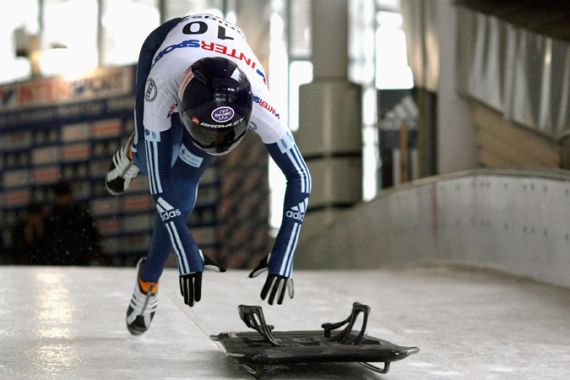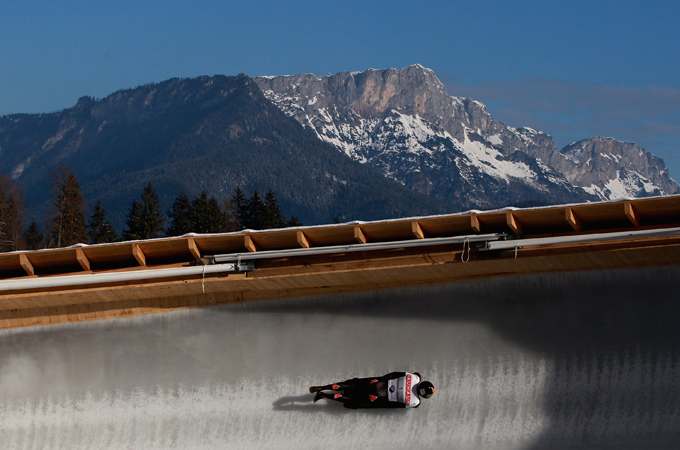The thrills of skeleton
It’s fast and there is no steering or brakes – the growing sport of skeleton is not for the faint-hearted.

In one year, the 2014 Winter Olympics in Sochi will have started over two weeks of sporting joy.
But before that, many sports have been holding World Championship events in 2013.
One sport making only its fourth appearance is skeleton.
With speeds of well over 130 km/h, you’d be forgiven for thinking that only those with a death wish would ever want to have a go at it.
Athletes lie on their front, facing forwards as they fly down an ice track, being flung around corners for less than two minutes.
An Olympic sport, it has its origins in Great Britain and Switzerland in the late 19th century, and has become very popular in recent years.
Since the first official inclusion as an Olympic event in 2002, the USA, Canada and Great Britain have led the way in terms of medals.
And as a sport, the idea is pretty ridiculous.
Yet the excitement far surpasses that of bobsleigh, or the luge. The risks seem much greater, and the rewards sweeter. The sled – which the athlete throws themselves on after the push start – has no steering or breaking devices, leaving everything to the skill of those on top.
Flying around chicanes and horseshoes, the slider runs the risk of hitting the top of a turn, bashing into a side wall or even being thrown out of the track altogether.
Memories of Georgian luger Nodar Kumaritashvili will live long, after he lost control on his practice run at the 2010 Olympics in Vancouver.
He was thrown off his sled, travelling at a massive 143.6 km/h, into a steel barrier and was killed.
Naturally, questions were raised about the safety of the sport, yet Kumaritashvili was the first fatality skeleton had seen since 1975.
Accidents are rare; more rare, it seems, than bobsleigh and luge. With a sport as potentially dangerous as skeleton, safety must be the first thought.
Growing popularity
In winter sports, it’s rare to see many ‘warm’ countries participating.
And yet the skeleton has more than its fair share.
Teams from Australia, Lebanon and Spain have all sent athletes to the Olympic games, but none have quite matched the achievements of Great Britain.
Amy Williams surprised the world by winning gold in Vancouver, Team GB’s only medal at the 2010 games, and Shelley Rudman has for years been at the top of the world rankings.
Rudman won the world cup in 2012, and followed that up by becoming Britain’s first world champion in St Moritz, the home of modern-day tobogganing.
Rudman, who has a child with fellow luger Kristan Bromley, told her daughter “I hope I didn’t scare you too much on that run” following her victory.
“It’s been super mad over the past few days with loads of interviews.” Rudman tweeted.
 |
| Blink and you’ll miss him: Latvia’s Martins Dukurs has dominated the past three seasons [GALLO/GETTY] |
Certainly a world title has kept British interest alive in the sport. And as is the norm these days, social media has played a massive part in that.
Such is their influence in the world of skeleton, GB athletes are some of the few winter sport stars supported by the British Olympic association.
Naturally, they’re not the only team winning races on the world cup circuit.
Latvia’s Martins Dukurs has dominated the past three seasons, winning seven of the eight races in the 2011-12 season.
And Germans Anja Huber and Marion Thees have been among the top women for the past five years, while there were two Australians in the top 10 of the 2011-12 season standings.
Huber is a frequent tweeter (“On the way to the track…gonna be a really long day”), giving inside information that isn’t often available through mainstream media.
But it’s the sports accessibility that really makes it great. As with any sport, the more it is in the media, it becomes more popular.
Having greater access to the athletes allows people to become interested in a sport, understanding the reality of high-level sport.
The more interest created by the athletes can only increase participation. And to see teams from every corner of the world, and not just from those with snow, is a real boost for winter sport.